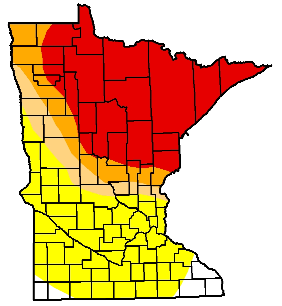Minnesota Drought Situation Report - February 21, 2007
| Drought Monitor - February 13, 2007 |
|---|

|

|
Drought status
The National Drought Mitigation Center Drought Monitor continues to place much
of northern Minnesota in the Extreme Drought or
Severe Drought categories.
Portions of central Minnesota are depicted in the Moderate Drought
classification. Most of the rest of Minnesota is depicted as being Abnormally Dry.
How the drought developed during summer 2006
Dryness was entrenched across much of northern and central Minnesota for the majority of the 2006 growing season. The timing of the dry weather was
unfortunate. Historically, the period from May through September is the wettest time of the year in Minnesota. In 2006 however, rainfall
totals fell well short of long-term averages in many locales, especially in northern Minnesota (see: rainfall maps). The dry
weather began in mid-May and continued through June. The dryness was then compounded by one of Minnesota's hottest Julys ever. This
led to the rapid intensification of drought. By the end of July, much of northern and
central Minnesota was categorized as experiencing an Extreme Drought. The summer rainfall deficits and hot weather caused
deteriorating crop conditions, dwindling stream flows, lowering lake levels, and increased the danger of wildfire. Impacts of the drought included: surface water appropriation
permit suspensions, municipal watering restrictions and bans, an agricultural disaster declaration for 36 counties, the lowest lake levels in 30 years, and a number of major wildfires.
Autumn 2006
Substantial rains in the late summer and early autumn brought relief to some central Minnesota counties. However, many northern counties were missed by these
rain events. Dry weather persisted through the autumn of 2006, notably worsening the situation in northeastern Minnesota and
rekindling concerns about topsoil moisture in portions of southern Minnesota. Fall rains are very efficient at replenishing the soil moisture profile. The lack of widespread,
ample autumn rains exaggerated and prolonged the drought situation in many areas of the state.
Potential drought issues facing northern Minnesota in 2007
Spring and summer precipitation totals will need to far exceed normal for surface water systems to recover quickly from the 2006 deficits. This is possible,
but not climatologically likely. The drought was quick to develop, but most likely the impacts will be slow to repair. In keeping with the dry pattern established
in 2006, snowfall totals during winter of 2006-2007 have thus far been well short of average. Much of the
northern two thirds of northern Minnesota reports snow depths that rank historically below the 5th percentile.
Some drought concerns for the 2007 growing season include:
- antecedent dry conditions, along with a continuation of sparse winter snow cover, could lead to an explosive spring wildfire situation
- streams dropping below protected flow thresholds after the spring melt
- low lake levels and associated water access issues
- ground water levels lowering in lagged response to precipitation deficits. Ground water levels will also respond to increased pumping pressures.
- inadequate soil moisture conditions further impacting agriculture, especially forage crops
- inadequate soil moisture conditions further stressing forest communities, making them more vulnerable to pests
Other Drought Information Resources
![]()
 Return to Minnesota Climatology Working Group Main page
Return to Minnesota Climatology Working Group Main page
URL: http://climate.umn.edu/doc/journal/drought_situation_report_2007.htm
Last modified: February 21, 2007